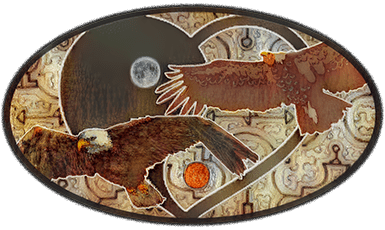Finding Your Way Back to Safety

The world feels heavy right now. There are sharp voices everywhere, constant divisions, arguments about what comes next. Underneath all of it, there’s something simple: we all want to feel safe.
That’s what we worked with on Sunday. Not safety as something we can control or manufacture, but as something we can return to in our own bodies, even when everything outside feels chaotic.
Why This Matters
Here’s what happens when we don’t feel safe: our bodies tighten up. Shoulders creep toward our ears. Breath gets shallow. Stomach clenches. We’re constantly braced for the next bad thing. That’s a normal human response to threat, but we can’t live like that all the time. It’s exhausting. It affects how we sleep, how we relate to other people, how we think.
This meditation wasn’t about pretending the world is fine when it’s not. It was about learning to work with our own nervous systems. When we’re stuck in that fight-or-flight response all day, we lose access to the parts of ourselves that can think clearly, respond thoughtfully, and actually deal with problems instead of just reacting to them.
So we practiced finding moments of calm in our bodies. Not to bypass legitimate concerns about the state of things, but to give ourselves a foundation to stand on when everything else feels unsteady.
Starting Where You Are
We began simple. Just sitting and noticing the surface beneath us. Feeling the chair or floor holding us up. That sounds basic, but when was the last time you actually let yourself be supported instead of holding yourself rigid all the time?
Then we worked with the breath. Four counts in through the nose, six counts out through the mouth. That longer exhale is important – it signals to your nervous system that it’s okay to relax. Your body responds to that rhythm.
Before we tried to feel better or fix anything, we acknowledged what’s actually present. Fear lives somewhere in your body. For some people it’s chest tightness. For others it’s a knot in the stomach, tension in the jaw, weight on the shoulders. We took time to just notice where it shows up, without trying to make it go away. Just “okay, this is fear, and I see it.”
You can’t work with something if you’re pretending it’s not there.
After that, we started shifting the relationship to fear through the breath. Inhaling and imagining drawing in safety – not as an abstract concept but as something you can actually feel. Maybe warmth in your chest. Maybe steadiness in your feet. Maybe just the simple rhythm of breath moving in and out. Then exhaling and releasing a bit of tension. Not forcing anything, just allowing a little softening with each breath.
Why We Worked With the Body
This is where the meditation gets interesting. We spent time moving through seven different areas of the body, and each one connects to different aspects of being human.
We started at the bottom – feet, legs, base of the spine. This is your foundation, your connection to what’s holding you up. We worked with the reality that it’s safe to exist, to be here, to belong. That might sound obvious, but a lot of us walk around with a low-level anxiety that we’re somehow not supposed to be taking up space in the world. Starting here matters because you can’t build anything stable without a foundation.
Then the lower belly and hips. This is where we hold deep emotion. Where feelings live in the body. Working with this area is about acknowledging that it’s safe to actually feel things, to be creative, to experience pleasure and enjoyment even when the world is hard. A lot of us shut this down because feeling things can be overwhelming. But shutting it down completely means we lose access to joy, connection, creativity – all the things that make life worth living.
Up to the upper belly, just below the ribs. This is where we feel personal power and confidence. It’s where “gut feelings” come from. This area is about trusting yourself, knowing you have strength, being willing to take up space. For a lot of people, especially if you’ve been taught to make yourself small or doubt your own judgment, working with this area can feel challenging. That’s okay. Just noticing that is useful.
The chest and heart. This is straightforward – it’s where we experience love, connection, care. Where vulnerability lives. Working here is about letting yourself love and be loved, letting yourself care deeply even when caring is risky or painful. A closed-off heart feels safer in the moment, but it cuts you off from what matters most.
The throat. This is your voice, your expression. It’s where truth lives. A lot of us learned early on that speaking up isn’t safe – that expressing who we really are might get us rejected or hurt. Working with this area is about reclaiming the right to be heard, to say what’s true, to express yourself authentically.
The space between the eyebrows. This is where we process information, where we see and understand. It’s about trusting your own perception, trusting what you know even when other people are telling you differently. In a world with constant information overload and gaslighting, being able to trust your own ability to see clearly matters.
And finally, the top of the head. This is about openness, learning, being part of something bigger than just your individual self. It’s safe to not have all the answers. It’s safe to be a student of life. It’s safe to be held by something larger – community, nature, the simple fact that you’re not alone in this.
We breathed into each area and spoke these statements out loud. For some people, some of these felt true immediately. For others, they felt impossible or brought up resistance. Both responses are completely normal and part of the process. Then we sat in silence for several minutes, just letting everything we’d touched settle into the body.
The Tool You Can Actually Use
After all that body work, we created something practical you can take into daily life. This is important because you’re not going to have 45 minutes to meditate when anxiety hits you in the middle of a workday or when you’re scrolling news at night and your chest starts to tighten.
Here’s the tool: place your hand on your heart. Feel the warmth of your palm against your chest. Feel your heartbeat underneath. That physical contact matters – it’s soothing, it’s grounding, it reminds you that you have a body and it’s right here, right now.
Then take one slow breath. Just one. Four counts in, six counts out.
While you do that, say a simple phrase to yourself. Something like “I am safe in this breath” or “The ground is holding me up” or “I can come back to this feeling” or “It’s okay to be exactly who I am.”
That’s the complete anchor: hand on heart, one breath, simple phrase.
We practiced this together for several minutes, letting it become something your body remembers. The repetition matters. You’re training your nervous system to associate this gesture with calm. So when you use it later in a moment of stress, your body already knows what to do.
When you’re out in the world and fear or anxiety shows up – and it will – you can use this anywhere. Middle of a meeting. Standing in line at the grocery store. Lying in bed at night. Nobody else even has to know you’re doing it. Hand on heart, one breath, your phrase. It gives you a way back to yourself.
If those body-based statements we practiced feel too big or untrue in the moment, that’s fine. Start smaller. “Right now, in this breath, I’m okay.” “I’m learning what safety feels like.” “I don’t have to figure everything out right now.” The point isn’t to convince yourself of something you don’t believe. The point is to interrupt the spiral of anxiety and bring yourself back to this moment, this breath, this body.
What This Practice Actually Does
This isn’t positive thinking. We’re not trying to manifest a different reality or pretend problems don’t exist. We’re doing something much more basic: we’re learning to regulate our own nervous systems.
When you’re stuck in chronic stress or fear, your body is constantly sending danger signals to your brain. Your brain responds by keeping you in high alert. That feedback loop keeps you reactive instead of responsive. You snap at people. You can’t sleep. You make decisions based on anxiety instead of clarity.
This practice interrupts that loop. It gives your body evidence that right now, in this moment, you’re actually okay. Your nervous system starts to calm. And from that calmer place, you have access to different responses. You can think more clearly. You can respond to people with more patience. You can make better choices about where to put your energy.
It’s not about achieving some permanent state where you never feel fear again. Fear is a normal human emotion and sometimes it’s giving you useful information. This practice is about building your capacity to return to calm when fear knocks you off balance. It’s about not getting stuck there.
If You Want to Try This at Home
You don’t have to do the full 45-minute version, though you certainly can. Here are some ways to work with these ideas at different time scales:
Five minutes: Find a quiet spot. Sit comfortably. Place your hand on your heart and just breathe. Four counts in, six counts out. When your mind wanders – and it will – just notice and come back to the breath and the feeling of your hand on your chest. That’s the whole practice.
Throughout your day: Set a reminder on your phone a few times a day to check in with your body. Where are you holding tension? Shoulders bunched up? Jaw clenched? Stomach tight? Just notice it. Then take three conscious breaths and see if you can soften that area even a little bit. You don’t have to fix it completely, just create a little space.
When anxiety hits: This is when you use the anchor we practiced. Stop whatever you’re doing for ten seconds. Put your hand on your heart. Take one slow breath. Say your phrase. “I am safe in this breath.” That’s it. You can do this a hundred times a day if you need to. Each time, you’re training your body to remember how to come back to calm.
The full practice: If you want to work through the whole body-based meditation, set aside 45 minutes when you won’t be interrupted. Move slowly through each area – feet and legs, lower belly, upper belly, chest, throat, forehead, top of head. At each spot, breathe and speak the statements we used. Notice what comes up without trying to force anything. Then sit in silence for 5-6 minutes and let it all settle. The silence at the end is just as important as the active parts.
Keep Showing Up
Some days this practice will feel profound and you’ll walk away feeling centered. Other days your mind will race the whole time and you’ll feel like you failed at meditation. Both of those experiences are normal. Both are part of the practice.
The point isn’t perfection. The point is showing up and trying. Each time you practice returning to calm, you’re strengthening that capacity. It’s like building muscle – you don’t see results after one workout, but consistent practice changes things.
The world is going to stay complicated. We can’t control that. But we can build our own ability to find moments of calm and clarity, even when everything outside is chaotic. And when you show up in the world from a place of relative calm instead of constant reactivity, you bring something different to your interactions. You respond instead of reacting. You have more patience. You make better decisions.
That matters.
A Reminder
If you were at the service on Sunday, hopefully this helps you remember what we did together and gives you ways to keep working with it. The practice doesn’t end when the meditation ends. It’s something you carry with you.
If you weren’t there, consider this an invitation. You don’t need any special training or equipment or beliefs. You just need some time and a willingness to notice what’s happening in your own body.
Your breath is always with you. Your body is always here. You can place your hand on your heart whenever you need to remember that you know how to find your way back to calm.
That’s always available.




Responses